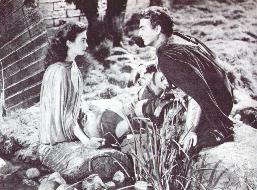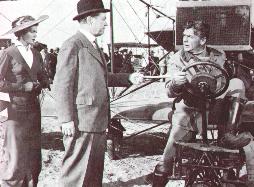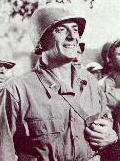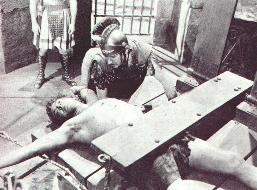

From almost any angle, Androcles and the Lion was unsatisfactory screen fare. One of the chief faults was that by extending the story from one hour to ninety-eight minutes, the plodding scenarists allowed the script to become "vulgar and shallow" (Saturday Review). As a motion picture, the satirical account of the Christian tailor, Androcles (Young), who earns lasting devotion from a lion from whose paw he has removed a thorn, was protracted and overly-cute, as well as replete with technical flaws. Miss Simmons as the Christian girl Lavinia, whom Victor loves and wins, was the film's saving grace.
Because Zanuck's Twentieth Century-Fox had such an overabundance of home-grown and borrowed male leads the top executives were perfectly willing to continue lending out Mature's screen services to any studio that put in a decent bid. MGM borrowed Victor for what was to be Esther Williams' most lavish Technicolor swim-musical, Million Dollar Mermaid (1952). During the life story of Australian-born Annette Kellerman (Williams), Victor, as James Sullivan, an American carnival promoter, meets the former polio victim in London after she has become the amateur swim champion of New South Wales. As a publicity stunt, he persuades her to swim twenty-six miles down the Thames River. Then they go to New York, but fail to get the desired Hippodrome booking. She finds notoriety of a different sort in Boston when she is arrested for indecent exposure in a swimsuit that is far removed from the swim fashion of the period. The publicity proves to be a springboard to success and she achieves her goal of appearing at the mammoth Hippodrome. When she shows more than a passing interest in the theatre's manager (David Brian), Mature's jealous James Sullivan departs for Hollywood. She, too, winds up in Hollywood where she suffers a severe accident on a studio set. Sullivan, now the promoter of a canine movie star, persuades her to regain her career confidence as well as her affections for him. Busby Berkeley conceived and directed two of Miss Williams' above-water ballet numbers, the most spectacular and unforgettable of which was produced with colored smoke streams.
Back at Twentieth, Victor received a leftover casting assignment as a bureaucratic Washington lobbyist in Something for the Birds (1952), a supposed comedy that struggled along on half a wing. He befriends Patricia Neal, badly miscast as a sort of early-day ecologist intent on saving the birds of California from extinction.
Victor began 1953 at Twentieth in the role of an American Army lieutenant of Greek parentage in Glory Brigade, doing battle on behalf of the United Nations forces in Korea. He is bitterly opposed to the leader (Alexander Scourby) of the infantrymen from Greece, whom he blames for the loss of a platoon. Lee Marvin, also in the cast, commented twenty years later to Ron Caylor of the National Enquirer, "I spent most of the filming with my hands over my eyes, hoping nobody would recognize me, it was so bad."
At RKO, for Affair with a Stranger (1953), Mature was required to play "comedy" with Jean Simmons. Neither of them did well in Richard Flournoy's trite screenplay. In this pallid tale, told mostly through flashback, Victor's Bill Blakeley is revealed as a playwright who would rather gamble than do anything else. He persuades his serious-minded wife-model Carolyn (Simmons), to support him until he makes the big times. His play opens the night their baby dies, and when they adopt a child later, Simmons' Carolyn devotes all her attention to it. One of the film's few passable moments occurs when Monica Lewis, as the siren of the piece, sings "Kiss and Run."
After four screen roles that threatened to stagnate his acting career, Victor was chosen by producer Frank Ross to fill the number three star slot in Twentieth's super-colossal The Robe (1953). Adapted from the Lloyd C. Douglas best-selling novel and directed by Henry Koster, it was the first feature to be filmed in CinemaScope, advertised as "the new dimensional photographic marvel you see without glasses!" This process was further heralded as the "greatest step forward in entertainment history" because of its miracle mirror screen (usually sixty-eight by twenty-four feet), Stereophonic Sound, and Anamorphic Lens.
Victor, described by Bosley Crowther in the New York Times as "muscular and moody," is Demetrius, the Greek slave of Marcellus Gallio (Richard Burton) and a convert to the teachings of Jesus. A loyal and dedicated believer in Christ, Demetrius is later joined in his belief by his Roman tribune-master who was in charge of the crucifixion. Gallio later becomes obsessed with Christ's robe after placing it about his shoulders. Jean Simmons, in her third appearance with Mature, is the lovely Roman lady, Diana, smitten with love for Burton's Gallio.
Nominated for Academy Awards in several categories, including Best Picture and Best Actor (Burton), the film garnered only a few in the final voting (art direction-set direction; costume design, and color). When asked by J. Marks of Interview, in 1972, if he resented never having won an Oscar, Victor replied, "Not really. I didn't deserve one to tell you the truth.... When I finally did something which a lot of people considered excellent--mean[ing] my role as Demetrius in The Robe, Zanuck repeatedly refused to put me up for the nomination as Best Supporting Actor because he insisted that there were no supporting actors in The Robe--only stars. That was the only thing I ever really liked seeing myself on the screen." Mike Connolly of the Hollywood Reporter also liked it and even had predicted in January, 1954, that both Victor and Jean Simmons would receive Oscar nominations.
Look Magazine predicted, "The Robe promises to be the picture that leads Hollywood out of the desert into the rich vineyards." It certainly proved a bonanza for Twentieth Century-Fox, eventually gaining for the studio $17.5 million in U.S.-Canadian distributors' rentals alone. It certainly revitalized Mature's career, leading some Hollywood jokesters to quip that in the new era CinemaScope, he was the only actor big enough to fill the big screen.
Just prior to the release of The Robe (on September 16, 1953), Victor, a golf fanatic by then, applied for a membership to the Los Angeles Country Club; he was told by a board member that the club did not accept actors. Kiddingly, Victor replied, "Hell, I'm no actor and I've got twenty-eight pictures and a scrapbook of reviews to prove it." The release of The Robe and the excellent reviews the film garnered for him belied that ironic comment.
A month later, to capitalize on Victor's prominence in The Robe, Universal released The Veils of Bagdad (1953) for which he had been borrowed earlier. Across the sands of Palm Springs, he swashed into action as a muscular palace guard in sixteenth-century Bagdad. In colorful costumes, he turns the heads of Mari Blanchard and Virginia Field, but what was required to match his zest was a leading lady of the Maria Montez mold. That sort of screen combination, had it ever materialized, might have proved very interesting.




